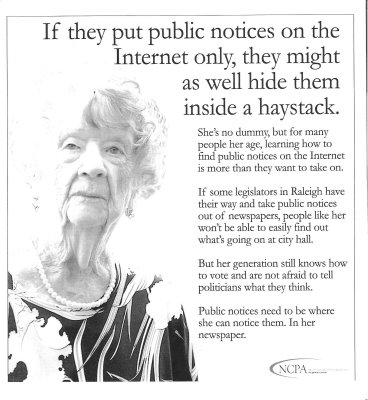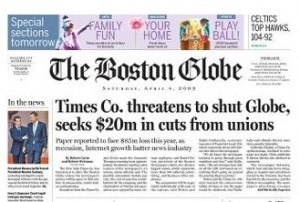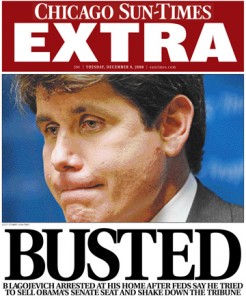 The New York Times Company shocked the newspaper industry last week with its threats close the Boston Globe on May 1 unless Globe unions give back $20 million in concessions. There’s new evidence that the May 1 date is a bluff and that closing down the Globe could cost the Times more than keeping it in business.
The New York Times Company shocked the newspaper industry last week with its threats close the Boston Globe on May 1 unless Globe unions give back $20 million in concessions. There’s new evidence that the May 1 date is a bluff and that closing down the Globe could cost the Times more than keeping it in business.
The Newspaper Guild is taking an initially defiant stance on the Times’ request that the union shoulder half of the $20 million in targeted cost savings. “We’re willing to consider some concessions but not the draconian amount they put forth,” said union president Daniel Totten, in an apparent call of the Times’ bluff. He also characterized the Times’s demand for freedom to lay off people without regards to seniority as “a nonstarter.” Globe reporter Scott Allen, who has a lifetime employment guarantee, commented “Now, nobody thinks that if we make these concessions, there won’t be more cuts in a few months.” Yes, Scott, we think you can count on that when the paper is losing $85 million a year.
The very act of closing the paper would trigger huge expenses in itself. The Boston Herald analyzed public records and found that union members could be entitled to up to 50 weeks of severance pay and that underfunded pension liabilities could swell the total cost to more than $100 million. Contractual obligations also make the Globe a tough property to sell, since few buyers would want to assume open-ended liabilities like the lifetime employment pledges to 435 employees. The only way to cancel the guarantees, apparently, is to close down the paper.
If the Times Co. plans to carry forward with its threats, it has yet to tell the government. The Worker Adjustment and Retraining Notification (WARN) act requires most employers with more than 100 employees to give 60 days’ notice of plant closings and mass layoffs. The Times Co. hasn’t yet filed a WARN notice, although it could still shutter the paper and pay employees for 60 days thereafter.
The Globe is raising its newsstand prices by as much as 60% in a gamble that readers will help pick up some of the bill for keeping the paper afloat. Residents outside of Boston will now pay $4 for a Sunday paper, compared to the current $2.50.
The Globe‘s crosstown rival Herald, which can barely disguise its glee in covering this story, also reports that four Guild leaders and six governing board executives are among those with lifetime job guarantees. Those guarantees are one of the biggest obstacles to selling the paper and are a primary negotiating point between the Times Co and the Globe unions. The guarantees are causing friction within Newspaper Guild ranks, as some members believe that the leadership will be unwilling to negotiate in good faith out of fear of losing their jobs.
 The Herald’s rapacious columnist, Howie Carr (left), skewers his blue-blooded competition for a series of past errors provoked by lapses in judgment. Too bad there are no hyperlinks; it would’ve been nice to read the background on this stuff.
The Herald’s rapacious columnist, Howie Carr (left), skewers his blue-blooded competition for a series of past errors provoked by lapses in judgment. Too bad there are no hyperlinks; it would’ve been nice to read the background on this stuff.
Meanwhile, the Globe itself notes a trend: newspaper owners are increasingly using the threat of closure to extract concessions from their unions. Hearst’s success in gaining significant givebacks from the union in order to keep the San Francisco Chronicle afloat may have prompted the Times Co. to threaten the Globe with oblivion. Also, Members of the Pacific Northwest Newspaper Guild in Seattle were scheduled to vote this week on accepting a wage freeze and two weeks of unpaid furloughs in exchange for keeping the Seattle Times afloat. A similar holdup is going on in Maine. Could it be that newspaper owners are merely posturing in order to gain concessions from the unions? Nah, they both have the higher goal of quality journalism in mind.
Is AP Worst Content Thief?
A new blog called The Future Of Newspapers features a guest column by veteran Denver sports writer Dave Krieger that poses a curious question: How can the Associated Press proposed to champion the intellectual property rights of newspapers when the AP is itself the worst violator of those rights? Krieger notes that readers don’t make a distinction between the source of information and where they consume it. News from the Denver Post that appears on ESPN.com is presumed to be from ESPN.
“Why should any newspaper in the Internet age be a member of an organization that takes that paper’s original material, rewrites it and distributes it around the world without attribution or compensation? In fact, an organization that charges the newspaper for the privilege?” The AP had some utility when newspapers were expected to provide national and international coverage, but obligation is gone now. For most metro dailies, the AP is nothing more than a subscription service that pirates their content and distributes it free on the Internet. He has a point.
Miscellany
Executives might want to look at what’s going on at the Virginian-Pilot, where management reports that the financial outlook is brightening even as it lays off another 40 employees. The company has cut nearly 20% of its workforce in the past year and reduced its newsroom staff by 30% since early 2007, but it has also taken some initiatives to diversify and grow revenue. These include targeted websites, expansion of entertainment coverage and contracts to deliver national newspapers in its region. While print revenue continues to fall, management said online revenue is growing. The newspaper turned a profit in the first quarter and March was its best month in a year.
Boston University’s newspaper asks three journalists-turned -academics if university partnerships could be a solution to newspapers’ financial troubles. They agree that university endowments could be an important source of support for failing journalist enterprises and that universities have a duty to support worthy cultural and public service institutions. However, educational institutions are not known for acting quickly and trustees would probably balk at taking on financial liabilities as daunting a complex as those that the industry faces.
Rosa Brooks fires a parting shot in her swan song as a Los Angeles Times columnist. She’s going to the Pentagon as advisor to the undersecretary of Defense for policy, but she fears that the evisceration of her industry will leave the American public wanting. She “can’t imagine anything more dangerous than a society in which the news industry has more or less collapsed.” Brooks believes that the government must step up to the plate and subsidize journalism, which isn’t the same as subsidizing media. The problem with existing subsidies is that they “have actually contributed to the decline of high-quality journalism by enabling monopolies, freezing out smaller and locally controlled media outlets and encouraging large corporations to treat the news as just another product,” she writes. The issue isn’t how to save the media, but how to save quality.
The Reno (Nev.) Gazette-Journal is laying off 35 people, or about 10 percent of its workforce, and closing a weekly paper in Carson City. These are in addition to 61 other positions eliminated since December. Do the math, and the paper has cut almost 25% of its workforce in the last four months.
Veteran newsman Ric Cox has launched a blog called “Save Our Tribune” that’s dedicated to “rescuing Chicago’s leading newspaper.” In one of his initial posts, he suggests ways that the Tribune can make online subscriptions palatable to users who are accustomed to getting news for free.
And Finally…
Some residents of Omaha, Neb. have created a satirical website to celebrate “Totally bogus news from the mid-heartland.” The principal target of its barbs is the Omaha World Herald, “which has laid off employees twice (usually after throwing an extravagant party for an ex-publisher), cut back circulation, and now runs obits where it used to run op-eds,” according to a promotional message. One of the early posts notes the possibility that the state may create a precedent in capital punishment due to a typographical error. “The state might be replacing the electric chair with ‘lethal infection’ rather than the intended ‘lethal injection,'” the editors write, noting that some members of the Senate Judiciary Committee actually like the idea. One of them “added an elegant provision permitting the use of a piece of rusty barbed wire to begin the process and inject the pathogens,” says the site.
 McClatchy Co. CEO
McClatchy Co. CEO  Vanity Fair uses a lot of words to describe Arthur Ochs Sulzberger Jr. in
Vanity Fair uses a lot of words to describe Arthur Ochs Sulzberger Jr. in 





 The London-based company principally serves up photos at the moment, but will expand into written journalism soon, according to CEO Turi Munthe (left). The business has signed on several high-profile newspapers and is hoping that its international scope will make it appealing to US journals that have had to lay off their international correspondents. Services like its
The London-based company principally serves up photos at the moment, but will expand into written journalism soon, according to CEO Turi Munthe (left). The business has signed on several high-profile newspapers and is hoping that its international scope will make it appealing to US journals that have had to lay off their international correspondents. Services like its 

